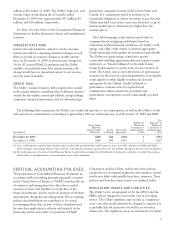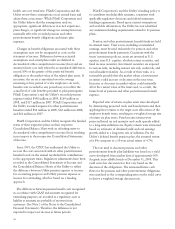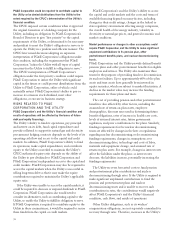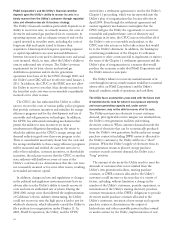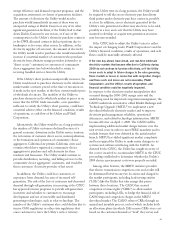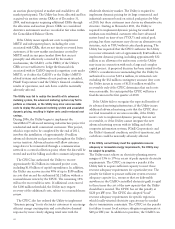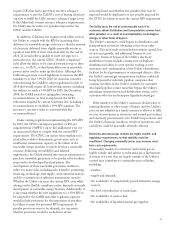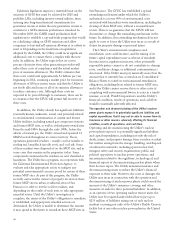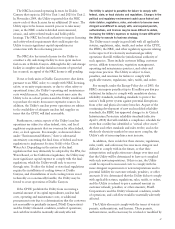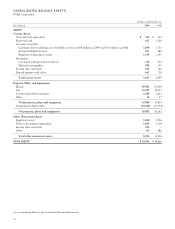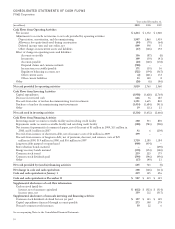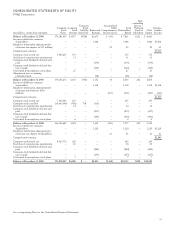PG&E 2009 Annual Report Download - page 47
Download and view the complete annual report
Please find page 47 of the 2009 PG&E annual report below. You can navigate through the pages in the report by either clicking on the pages listed below, or by using the keyword search tool below to find specific information within the annual report.require LSEs that fail to meet their resource adequacy
requirements to pay the CAISO’s cost of buying electricity
capacity to fulfill the LSEs’ resource adequacy target levels.
If the Utility fails to meet resource adequacy requirements,
the Utility may be subject to penalties imposed by the
CPUC and the CAISO.
In addition, California law requires retail sellers such as
the Utility to comply with the RPS by increasing their
deliveries of renewable energy each year so that the amount
of electricity delivered from eligible renewable resources
equals at least 20% of their total retail sales by the end of
2010. If a retail seller is unable to meet its target for a
particular year, the current CPUC “flexible compliance”
rules allow the deficit to be carried forward for up to three
years (i.e., to 2013), so that future deliveries of renewable
power can be used to make up the deficit. Although the
California governor vetoed legislation to increase the RPS
mandate to at least 33% by 2020, he issued an executive
order directing the CARB to adopt regulations by July 31,
2010 that would require all load-serving entities, including
the utilities, to reach a 33% RPS by 2020. (In December
2008, the CARB issued a scoping plan containing
recommendations on how to implement the GHG
reductions required by current California law, including a
recommendation to establish a 33% RPS mandate. The
governor’s executive order is consistent with this
recommendation.)
Under existing regulations implementing the 20% RPS
by 2010, the CPUC can impose penalties of $50 per
megawatt-hour (“MWh”), up to $25 million per year, for
an unexcused failure to comply with the current RPS
requirements. The CPUC can excuse noncompliance if a
retail seller is able to demonstrate good cause, such as
insufficient transmission capacity or the failure of the
renewable energy provider to timely develop a renewable
resource. Following several RFOs and bilateral
negotiations, the Utility entered into various agreements to
purchase renewable generation to be produced by facilities
proposed to be developed by third parties. The
development of these renewable generation facilities is
subject to many risks, including risks related to permitting,
financing, technology, fuel supply, environmental matters,
and the construction of sufficient transmission capacity.
Whether the Utility can meet the current RPS, even while
relying on the flexible compliance rules, depends on timely
development of renewable energy facilities. Additionally, it
is uncertain whether the new regulations for a 33% RPS to
be adopted by the CARB and other regulatory agencies
would include provisions for the imposition of penalties
for failure to meet the increased RPS requirement. If
penalty provisions were to be adopted, it is uncertain
whether provisions would be included to excuse
noncompliance and whether any penalties that may be
imposed would be duplicative of any penalty imposed by
the CPUC for failure to meet the current RPS requirement.
The Utility faces the risk of unrecoverable costs if its
customers obtain distribution and transportation services from
other providers as a result of municipalization, technological
change, or other forms of bypass.
The Utility’s customers could bypass its distribution and
transportation system by obtaining service from other
sources. This may result in stranded investment capital, loss
of customer growth, and additional barriers to cost
recovery. Forms of bypass of the Utility’s electricity
distribution system include construction of duplicate
distribution facilities to serve specific existing or new
customers and condemnation of the Utility’s distribution
facilities by local governments or municipal districts. Also,
the Utility’s natural gas transportation facilities could risk
being bypassed by interstate pipeline companies that
construct facilities in the Utility’s markets, by customers
who build pipeline connections that bypass the Utility’s
natural gas transportation and distribution system, or by
customers who use and transport liquefied natural gas.
If the number of the Utility’s customers declines due to
municipalization or other forms of bypass and the Utility’s
rates are not adjusted in a timely manner to allow it to fully
recover its investment in electricity and natural gas facilities
and electricity procurement costs, PG&E Corporation’s and
the Utility’s financial condition, results of operations, and
cash flows could be materially adversely affected.
Electricity and natural gas markets are highly volatile, and
regulatory responsiveness to that volatility could be
insufficient. Changing commodity prices may increase short-
term cash requirements.
Commodity markets for electricity and natural gas are
highly volatile and subject to substantial price fluctuations.
A variety of factors that are largely outside of the Utility’s
control may contribute to commodity price volatility,
including:
• weather;
• supply and demand;
• the availability of competitively priced alternative energy
sources;
• the level of production of natural gas;
• the availability of nuclear fuel;
• the availability of liquefied natural gas supplies;
43


